Writer's den
Revisiting our Russian friends
Reviewed by Winston Rupasinghe
 |
|
`Reminiscences of 50 years of
Sri Lanka-Soviet Russian relations’
Author: Sirimanna Karunatilake |
Sirimanna Karunatilake has to be congratulated for producing a
monumental literary work based on reminiscences of 50 years of Sri
Lanka-Soviet Russia relations which records in great detail the pathway
in establishing and developing relations between Sri Lanka and Soviet
Russia.
Karunatilake has had the unique opportunity of personally associating
with some of the main personalities who played a decisive role in
building the said relationship between the two countries since the late
Prime Minister S.W.R.D. Bandaranaike opened the `window' to the
socialist countries in 1956 by sending delegations to USSR and Peoples
Republic of China to establish diplomatic relations with the two
countries. Two such persons, namely T.B. Subasinghe, then Deputy
Minister of Foreign Affairs of the S.W.R.D. Bandaranaike Government and
Vladimir Yakovlev, the first Soviet Ambassador to Sri Lanka are being
duly honoured by the author in dedicating this book to their memory.
After a brief explanation of the birth of the Soviet State in 1917,
the author dwells on the awakening of Ceylon's independence struggle
which received a major impetus with the defeat of Nazi Germany by the
Soviet Union in 1945. Many Sri Lankans would also be intrigued with the
details of Anton Chekov's visit to Ceylon in 1890s, as recollected by
Karunatilake.
The first government delegation sent to the Soviet Union comprising
Sri Claude Corea, Ceylon's High Commissioner in UK, T.B. Subasinghe and
two other government officials had visited Moscow, Leningrad, Dushanbe,
Alma-Ata and major Siberian cities such as Novosibirsk and Irkutsk.
Karunatilake has given wide details of places visited by the delegation
and also the massive development programs embarked upon by the Soviet
Union in their first five year plan in these areas. He has also
described the inauguration of the Sri Lanka Embassy in Moscow by
Ambassador Dr. Gunapala Malalasekara and the inauguration of the Soviet
Embassy in Colombo by Ambassador Vladimir Yakovlev. Karunatilake has
given the insight to many interesting episodes in the experience of the
two Ambassadors in their early days.
T.B. Subasinghe was appointed as the Sri Lankan Ambassador to the
Soviet Union in 1961 and he served in this post till 1964. Mrs. Sirimavo
Bandaraniake's first official visit to the Soviet Union was in 1963.
Yuri Gagarin, the first human being to enter the outer space, visited
Sri Lanka in December, 1961. Yuri Gagarin's visit to Sri Lanka was a
legendary one. He was greeted by the people with great enthusiasm. All
these events have been described with vivid details by Karunatilake. The
setting up of major industries in Sri Lanka such as the Oruwala Steel
Factory, Kelaniya Tyre Factory and Mutuwal Flour Mill during this period
were with Soviet aid.
The Soviet Government offered undergraduate scholarships to hundreds
of Sri Lankans from 1960 with the establishment of the Peoples
Friendship University in Moscow. Karunatilake has taken great pains to
describe the experiences of several Sri Lankan students depicting the
comforts of student life, care and friendliness of the Russian people
towards these young Sri Lankans. Descriptions of many higher educational
institutions indifferent cities of the Soviet Union that afforded
opportunities for higher education to Sri Lankans in the following years
are also included in the book.
Part II of the book describes the activities of social organisations
which helped to strengthen the friendly relations between the peoples of
Sri Lanka and Soviet Russia. The Lanka-Soviet Friendship League and he
Soviet Cultural Centre played a major role in liaising with the
Soviet-Sri Lanka Friendship Society established in Moscow in 1959.
George Rajapaksa, who held many Cabinet posts in the Government was the
first President of Lanka-Soviet Friendship League. He rendered yeoman
service to the development of Sri Lanka-Soviet ties. Mrs. Lalitha
Rajapaksa was an honoured guest at the launching ceremony of this book.
The listing of the Ambassadors of Sri Lanka and Soviet Union in a
chronological order and recollection of other memorable persons are some
of the valuable information embodied in this book.
Finally, as a student of the Peoples Friendship University from 1962
to 1967 and as a member of the Lanka-Soviet Friendship League since 1967
and subsequently Vice President of Sri Lanka-Russian Friendship Society,
I wish to express my appreciation and sincere gratitude to Sirimanna
Karunatilake for the admirable task of producing this novel literary
work on Sri Lanka Russian relations encompassing a period of 50 years.
Ritwick Ghatak-Ridee Thiraye Karalikaruwa:
Candid biography of a revolutionary filmmaker
by Indeewara THILAKARATHNE
Ritwick Ghatak's biography comes in Sinhala at a time when Sinhala
cinema is at a cross road.
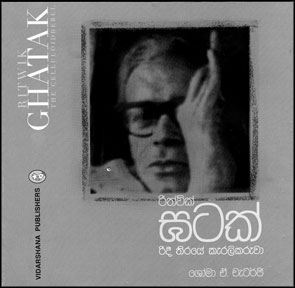 Manubandu Vidyapathy's translation of the biography of revolutionary
filmmaker Ritwick Ghatak by Shoma A. Chattergee into Sinhala would, to a
certain extent, fill the intellectual vacuum in the arena of study of
cinema and cinema personalities in Sri Lanka. The book comes in a handy
cover with a snap of the filmmaker and was published by Vidarshana
Publishers. Manubandu Vidyapathy's translation of the biography of revolutionary
filmmaker Ritwick Ghatak by Shoma A. Chattergee into Sinhala would, to a
certain extent, fill the intellectual vacuum in the arena of study of
cinema and cinema personalities in Sri Lanka. The book comes in a handy
cover with a snap of the filmmaker and was published by Vidarshana
Publishers.
A significant aspect of Ghatak's life and his career in cinema was
that it marked an important epoch in the Indian cinema. The birth of
Bangladesh and turbulent time in the post -independent political history
of India, had a profound influence on Ghatak's works.
"In 1947 Ghatak faced the tragedy of partition and lost his home in
Bangladesh in the process which was subsequently manifested in his work"
translates Manubandu in an evocative diction in Sinhala. It is indeed
rare that translators who have really understood not only the
superficial meaning of the lines but also the subtle nuances interwoven
with them in the original text. Manubandu belongs to this rare breed of
translators who are able to translate not only the lines but also
distinct voices in the original work.
His translation of the biography of Ritwick Ghatak stands as a model
translation which is marked for its highly evolved language. Manubandu
should be commended for fulfilling an intellectual vacuum in the study
of cinema in Sri Lanka.
One of the stumbling blocks in the path of mono-lingual students is
the lack of high quality study material especially on cinema and Drama
and Theatre in Sinhala.
Perhaps, one of the rare characteristics of Manubandu's translation
is that his innate ability to absorb facts from the original text and
translate them into Sinhala in an evocative as well as informative
diction. The translator has attempted, at all times, to stick to a
down-to-earth language avoiding ambiguities.
He has also taken an objective approach in dealing with the subject
at hand. However, true to the original, Manubandu has brilliantly
captured the voices in the original text and rendered them into Sinhala
in a most natural manner.
Translation is so good that stands as a commendable prose in Sinhala.
It should be a must read for students of Cinema and it would also
provide an informative read for deserving Sinhala readership.
Fine collection of articles
Kadapatha (The Looking Glass-Sixty Years of Independence), a
collection of articles from the Sunday Lankadeepa weekly column of the
same name written by Milinda Moragoda and edited by veteran Editor
Edmond Ranasinghe.
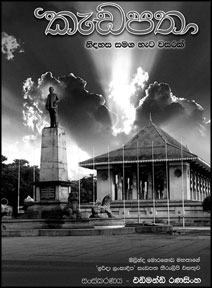 |
|
Kadapatha |
The book brings together a selection of fifty-five articles, which
appeared during the period of September 2007-February 2009. The
Kadapatha column-launched a few months before the 60th Anniversary of
Sri Lanka's Independence-critically evaluates the progress and setbacks
we have made since then, exploring pertinent areas such as political
reforms, governance, ethnic and cultural relations, economic reforms,
women's affairs, education policy, international affairs, etc.
The column ultimately argues for following a `middle-path' approach
away from extremism, to meet our society's challenges.
A television program created and hosted by Moragoda entitled
Nidhahasa (Freedom), which was aired on television in early 2008, was
initially run parallel to the column. Currently, Moragoda's ongoing
weekly radio program, Sanvada (Dialogue) continues as examination of
these issues. Podcasts of this show can be listened to on his website
milinda.org.
Kadapatha is the latest in a series of columns by Moragoda, who has
written regularly for over a decade for several newspapers on social,
cultural, political and economic matters.
His earlier columns include Arthika Vigrahaya (Economic Review)
Sathiye Sithiwilla (Weekly Thoughts) and Loka Nayakayan (World Leaders).
The latter two columns have appeared in the Tamil press, translated,
along with Kadapatha (which is presently running).
Book launch:
Punchi Kale Man out on March 6
 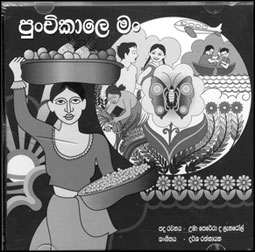 Uma Perera De Lanerole will launch her anthology of children's songs
Punch Kale man and the CD on Friday, March 6 at the Jana Kala Kendra,
Battaramulla at 3 p.m. Speaker W.J.M. Lokubandara will be the chief
guest. Uma Perera De Lanerole will launch her anthology of children's songs
Punch Kale man and the CD on Friday, March 6 at the Jana Kala Kendra,
Battaramulla at 3 p.m. Speaker W.J.M. Lokubandara will be the chief
guest.
The Ministry of Education has recommended the anthology and the CD as
suitable for primary and pre-school students. Music composition for the
CD was by Darsha Rathnayake and the drawings by Senananda Indrajith
Merthes.
Amavathura
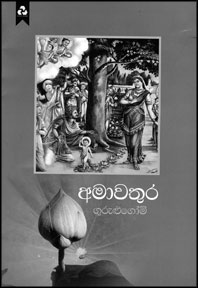 Gurulugomi's Amavathura, edited by Norman Siripala, will be launched
at Dayawansa Jayakody Book Exhibition Hall, Ven. S. Mahinda Mawatha,
Colombo 10 on Saturday, March 7. Gurulugomi's Amavathura, edited by Norman Siripala, will be launched
at Dayawansa Jayakody Book Exhibition Hall, Ven. S. Mahinda Mawatha,
Colombo 10 on Saturday, March 7.
Mr. Siripala is the author of several other literary works such as "Janakavi
Ashritha Katha, Sinhala Janakaviye Samaja Darshanaya, Janakavi Adyanaya,
Sinhala theravili sivpada, Jana Kaviya saha Jana Jeevithaya", and "thalamal
Kavi Samajaya".
"Amavathura" is published by Dayawansa Jayakody Book Publishers,
Colombo 10.
Book news:
Pluralism in South Asia
Here are the excerpts of the speech made by the High Commissioner of
Canada Angela Bogdan at the official book launch of The Powers and
Limits of Pluralism in South Asia
It is a great pleasure to host the official book launch of Pluralism
in South Asia. This book is the product of a successful conference
hosted by the NPC last March. Both the event and creation of this book
were supported by the Government of Canada. I would like to express my
appreciation to the National Peace Council for their hard work and
assistance.
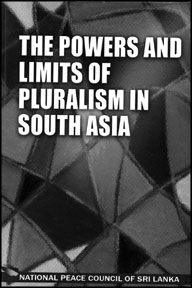 Canada is an example of the positive effects of pluralism but, like
many other countries, Canada must also address the challenges of
integrating an increasingly diverse population. Canada is an example of the positive effects of pluralism but, like
many other countries, Canada must also address the challenges of
integrating an increasingly diverse population.
The world lives within Canadian borders and we pride ourselves on our
commitment to promoting pluralism both domestically and internationally.
Our experience in promoting pluralism is based upon the importance we
accord to fostering intercultural relationships in Canada. Our country
is a more vibrant, prosperous, and energetic country thanks to the
contributions of our diverse people.
Canada also has the largest population of Sri Lankans outside of Sri
Lanka - the majority of them Tamil. The long-running conflict in this
country and the humanitarian crisis in the North are not only challenges
in Sri Lanka but in Canada as well.
One of the results of us becoming a more integrated world is the
increased interaction between peoples and ideas.
There are concerns on the part of some that their way of life is
changing, not of their own accord, but in response to other influences
and events. In some cases this has led to tensions between different
ethnicities, cultures and faiths.
South Asia in general and Sri Lanka specifically have fallen victim
to acts of terrorism. Blame is often placed on the tensions between
cultures and ethnicities as the root cause of this type of violence.
However we must remember that religion, ethnicity and culture aren't the
reason why violence occurs, but lines can be drawn based on these
markers of identity.
In the past Sinhalese, Tamil, Muslim and Burgher have lived
peacefully together. Sri Lanka still remains one of the most pluralist
societies in South Asia. That is why Canada chose to partner with an NGO
in Sri Lanka - so that we could learn from each others' successes and
challenges.
The Government of Sri Lanka has publicly declared its commitment to
the goal of a pluralistic Sri Lanka where all communities can realize
their legitimate aspirations.
As the military phase of the ethnic conflict appears to approach it
conclusion, we all need to strive towards a political solution that can
accommodate the legitimate aspirations of Sri Lanka's communities.
We must look to our governments and to each other to help find
innovative solutions to fostering better understanding and cooperation
between people.
The work the National Peace Council and the creation of Pluralism in
South Asia help us move toward this common goal. |


